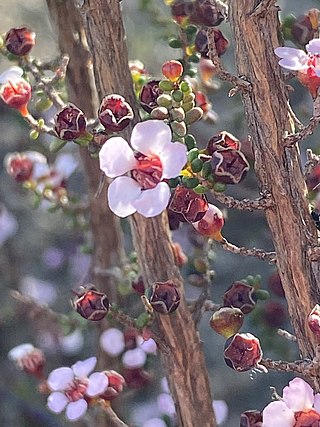
Thryptomene is a genus of flowering plants in the family Myrtaceae and is endemic to Australia. Plants in the genus Thryptomene are shrubs with small leaves arranged in opposite pairs and white or pink flowers. About forty-seven species of Thryptomene, occurring in all Australian states and the Northern Territory, have been formally described.

Rinzia orientalis, commonly known as desert heath-myrtle, is a species of flowering plant in the family Myrtaceae and is endemic to south-eastern Australia. It is a shrub with elliptic to narrowly oblong leaves and white or pale pink flowers usually with ten stamens.

Thryptomene australis, commonly known as hook-leaf thryptomene, is a species of flowering plant in the family Myrtaceae and is endemic to the south-west of Western Australia. It is an erect, bushy and spreading shrub with upward-pointing leaves with the tip curving outwards, and flowers with white petals arranged spike-like near the ends of the branchlets.
Thryptomene costata is a species of flowering plant in the family Myrtaceae and is endemic to Western Australia. It is an erect shrub with upward pointing, egg-shaped leaves with the narrower end towards the base, and white or pink flowers with five petals and ten stamens.
Thryptomene caduca is a species of flowering plant in the family Myrtaceae and is endemic to a small area in the north-west of Western Australia. It is a spreading shrub with crowded egg-shaped leaves with the narrower end towards the base, and pink flowers with five petals and seven to nine stamens.
Thryptomene calcicola is a species of flowering plant in the family Myrtaceae and is endemic to a small area in the north-west of Western Australia. It is an erect, sometimes spreading shrub with upwards-pointing linear leaves, and pinkish-mauve flowers with five petals and ten stamens.
Thryptomene decussata is a species of flowering plant in the family Myrtaceae and is endemic to Western Australia. It is an erect shrub with upward pointing, egg-shaped leaves, and white or pink flowers with five petals and twenty to thirty stamens in two whorls.
Thryptomene dampieri is a species of flowering plant in the family Myrtaceae and is endemic to the north-west of Western Australia. It is a low, spreading shrub with prostrate stems, broadly egg-shaped leaves with the narrower end towards the base, and pinkish flowers with five petals and ten stamens.
Thryptomene duplicata is a species of flowering plant in the family Myrtaceae and is endemic to Western Australia. It is a spreading shrub with upward pointing, egg-shaped leaves with the narrower end towards the base, and white flowers with five petals and about fifteen stamens in two whorls.
Thryptomene eremaea is a species of flowering plant in the family Myrtaceae and is endemic to Western Australia. It is an erect shrub with upward-pointing, oval leaves and white or pale pink flowers with five petals and ten irregularly arranged stamens.
Thryptomene globifera is a species of flowering plant in the family Myrtaceae and is endemic to western areas of Western Australia. It is a shrub with crowded, upward-pointing, broadly egg-shaped leaves with the narrower end towards the base, and pale pink or mauve flowers with ten stamens.
Thryptomene hubbardii is a species of flowering plant in the family Myrtaceae and is endemic to a small area in the west of Western Australia. It is a spreading shrub with crowded broadly egg-shaped leaves with the narrower end towards the base, and flowers with five pale pink petals and nine or ten stamens.
Thryptomene johnsonii is a species of flowering plant in the family Myrtaceae and is endemic to a restricted area of Western Australia. It is a bushy shrub with rigid branches, egg-shaped leaves with the narrower end towards the base and pink flowers with five petals and usually eight stamens.

Thryptomene mucronulata is a species of flowering plant in the family Myrtaceae and is endemic to Western Australia. It is an erect shrub with upward-pointing, overlapping, egg-shaped leaves with the narrower end towards the base and pink flowers with five petals and ten stamens.
Thryptomene naviculata is a species of flowering plant in the family Myrtaceae and is endemic to central areas of Western Australia. It is a rounded shrub with overlapping, decussate, egg-shaped leaves with the narrower end towards the base and white flowers with five petals and five stamens.
Thryptomene nealensis is a species of flowering plant in the family Myrtaceae and is endemic to central areas of Western Australia. It is a shrub with overlapping, decussate, linear leaves and pink flowers with five petals and usually five stamens.
Thryptomene nitida is a species of flowering plant in the family Myrtaceae and is endemic to a small area in the south-west of Western Australia. It is a spreading shrub with upward-pointing, egg-shaped leaves with the narrower end towards the base, and flowers with five pale purple or pinkish petals and ten stamens.
Thryptomene orbiculata is a species of flowering plant in the family Myrtaceae and is endemic to the west of Western Australia. It is a shrub with broadly egg-shaped to more or less round leaves, and flowers with five pinkish petals and usually ten stamens.
Thryptomene pinifolia is a species of flowering plant in the family Myrtaceae and is endemic to Kalbarri National Park in Western Australia. It is a shrub with linear leaves, and flowers with pale pinkish sepals and petals and seven or eight stamens.
Thryptomene podantha is a species of flowering plant in the family Myrtaceae and is endemic to the west of Western Australia. It is a shrub with egg-shaped leaves with the narrower end towards the base, and flowers with pink sepals and petals and ten stamens.




